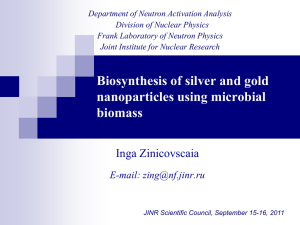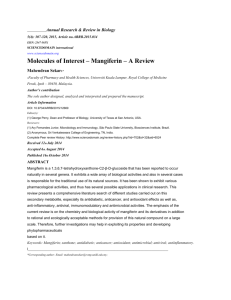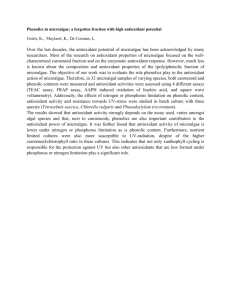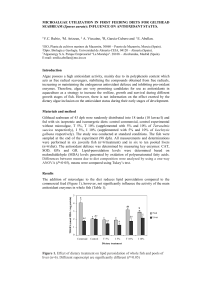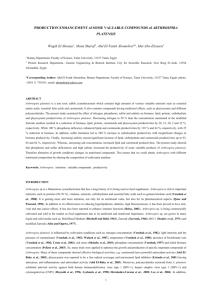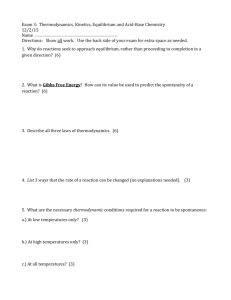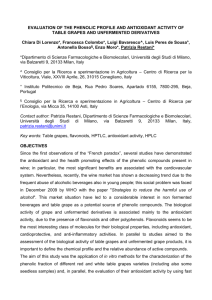Selenium-induced changes in antioxidant enzymes and
advertisement
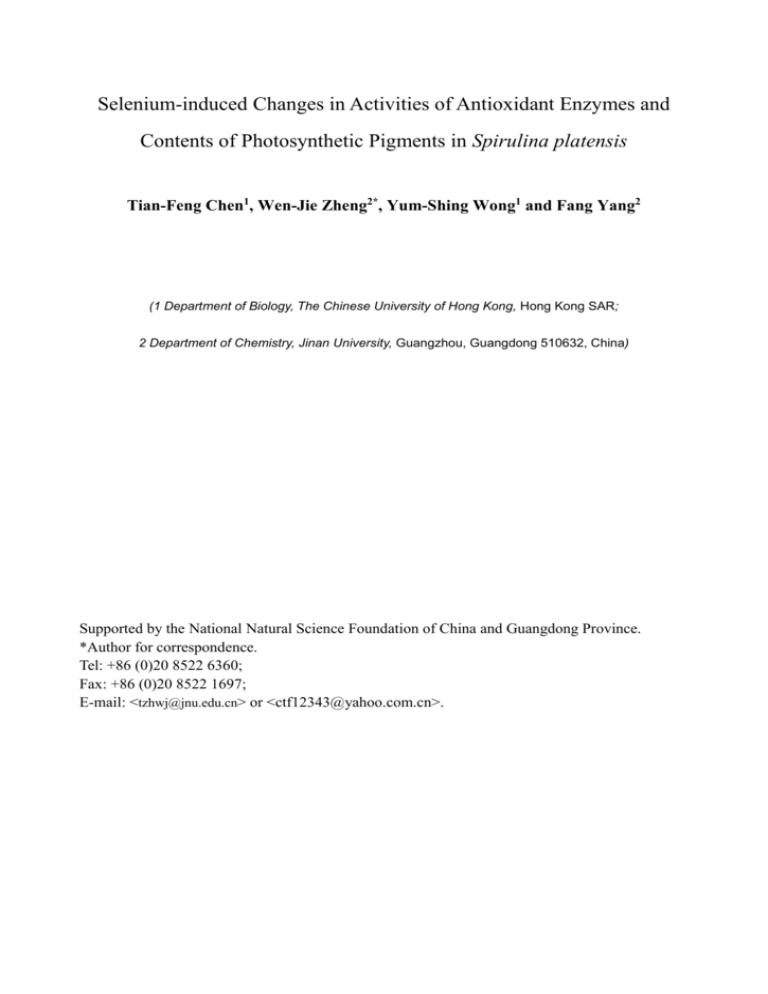
Selenium-induced Changes in Activities of Antioxidant Enzymes and Contents of Photosynthetic Pigments in Spirulina platensis Tian-Feng Chen1, Wen-Jie Zheng2*, Yum-Shing Wong1 and Fang Yang2 (1 Department of Biology, The Chinese University of Hong Kong, Hong Kong SAR; 2 Department of Chemistry, Jinan University, Guangzhou, Guangdong 510632, China) Supported by the National Natural Science Foundation of China and Guangdong Province. *Author for correspondence. Tel: +86 (0)20 8522 6360; Fax: +86 (0)20 8522 1697; E-mail: <tzhwj@jnu.edu.cn> or <ctf12343@yahoo.com.cn>. Abstract Spirulina platensis (S. platensis) exposed to various selenium (Se) concentrations (0, 10, 20, 40, 80, 150, 175, 200, 250 mg/L) accumulated high amount of Se in a dose- and time- dependent manner. Under low Se concentrations (≤150 mg/L), Se induced increases in biomass concentration, contents of photosynthetic pigments, and activities of guaiacol peroxidase (GPX), superoxide dismutase (SOD), catalase (CAT) and Gua-dep peroxidases (POD), which indicated that antioxidant enzymes played an important role in protecting cells from Se stress. Higher Se concentrations (≥ 175 mg/L) led to higher Se accumulation and increases in activities of GPX, SOD, CAT and POD, but also induced lipid peroxidation (LPO) coupled with potassium leakage and decreases in biomass concentration and contents of photosynthetic pigment. The results indicated that increases in activities of the antioxidant enzymes were not sufficient to protect cell membrane against Se stress. Time-dependent variations in the activities of antioxidant enzymes, contents of chlorophyll a and carotenoid and the LPO level were also investigated under representative Se concentrations of 40 and 200 mg/L. Opposite variation trends between SOD-CAT activities, and GPX-POD-APX activities were observed during the growth cycles. The results showed that the prevention of damage to cell membrane of S. platensis cells could be achieved by cooperative effects of SOD-CAT and GPX-POD-APX enzymes. This study concludes that S. platensis possessed tolerance to Se and could protect themselves from phytotoxicity induced by Se by altering various metabolic processes. Keywords: selenium; Spirulina platensis; accumulation; antioxidant enzymes; photosynthetic pigments. The trace mineral selenium (Se) is an essential nutrient of fundamental importance to human biology (Rayman 2000;Zheng et al. 2001). Both Se deficiency and toxicity occur worldwide, depending on Se availability in the environments (Zhang et al. 2007). Since it is generally believed that organic Se compounds are better and safer than inorganic Se as a dietary supplement, a variety of Se-enriched biological products including garlic, yeast, and lactic acid bacteria etc. have been commercialized. The Se supplementation using microorganisms has received much attention in the past decade (Chasteen and Bentley 2003). Se was also found toxic at high intake for human, animals and plants. Toxicity of Se is thought to occur due to its indiscriminative substitution of sulfur into proteins(Brown and Shrift, 1982), the prooxidant ability to catalyze the oxidation of thiols and simultaneously generate superoxide Stewart et al, 1999). All aerobically growing microorganisms encounter toxic, reactive oxygen species (ROS) (Halliwell and Gutteridge, 1999). These toxic forms of activated oxygen react with cellular components resulting in oxidation of proteins and nucleic acids as well as lipid peroxidation, leading further to inactivation of enzymes, disruption of membranes, mutations, and ultimately cell death (Imloy and Linn, 1998;Halliwell and Gutteridge, 1999). Plant cell’s defence against the damaging effects of oxidative stress involves both enzymatic and non-enzymatic components (Candan and Tarhan, 2003). The enzymatic components may directly scavenge reactive oxygen species (ROS) or may act by producing a non-enzymatic antioxidant. A variety of non-enzymatic antioxidants such as carotene, ascorbate, a-tocopherol may play an important role in the cellular response to oxidative stress by reducing certain ROS (Mager and De Kruijft, 1995). Superoxide radicals generated are converted to H2O2 by the action of superoxide dismutase (SOD). The accumulation of H2O2 is prevented in the cell by guaiacol peroxidase, catalase and peroxidases (GPX, CAT and POD), or by the ascorbate-glutathione cycle where ascorbate peroxidase (APX), reduces it to H2O (Donahue et al, 1997). Among these, the GPX level was changed in response to various physical, chemical and biological stresses. Changes in GPX activity and isozyme profiles have been suggested as indicators for environmental stresses (Lee, 2002). Till now, many works have been carried out to study the physiological roles of Se in higher plants (Xue et al, 1993; Huang et al, 1994; Hartikainen et al, 2000;Golubkina et al, 2005; Zhang et al, 2007). However, the involvement of antioxidant system in the cell response to Se is still unclear. The question as to how Se acts at the cellular level and how plants defend themselves against Se stress is receiving increasing attention. Spirulina platensis (S. platensis), a blue-green microalgae, has long been grown photoautotrophically for production of functional food. Many works have shown that S. platensis was a good carrier for Se accumulation. Furthermore, Se accumulation could improve the quality of S. platensis by enhancing the production of its biomass, photosynthetic pigments and protein concentrations (Huang et al, 2001, 2002; Li et al, 2003;Zheng et al, 2003a, 2003b; Chen et al, 2005, 2006a, 2006b). However, we also found that Se has toxic effects on the growth of S. platensis depending on the Se levels (Chen et al, 2005, 2006a). Till now, less information on Se-induced oxidative stress and antioxidant response in S. platensis could be obtained. The objective of this study was to investigate the accumulation of Se in S. platensis and its effects on the antioxidant systems (including antioxidant enzymes and non-enzyme components). This study may offer some insight into mechanisms underlying Se tolerance and accumulation in plants and enhance our understanding of the interaction between Se and S. platensis. Results Se accumulation and its effects on biomass and contents of photosynthetic pigments in S. platensis According to our results shown in Fig.1A, S. platensis accumulated Se efficiently during the cultivation and biotransformed the inorganic Se to organic Se at a high rate. Se content in S. platensis increased significantly with Se in culture media from 0 to 250 mg/L (P < 0.05). The Se species accumulated mainly consisted of organic Se (above 70%) and inorganic Se (< 30%) respectively, indicating that S. platensis was a good carrier for Se enrichment. Se accumulation and biotransformation significantly (P < 0.05) affected the growth of S. platensis, which was reflected by changes in biomass concentration. As shown in Fig.1B, Se has either stimulating or toxic effects on S. platensis depending on the Se levels in media. The increase in biomass concentration was obtained in cells exposed to low Se concentrations (≤150 mg/L), with the highest one (1.69g/L) found at the Se concentration of 40 mg/L. The even higher initial Se concentrations (≥ 175 mg/L) resulted in lower biomass concentration, which might be due to the toxic effects of high Se stress. In particular, cultures were found to turn red due to the occurrence of elemental Se, when S. platensis was exposed to Se at concentrations ≥ 300 mg/L and the color would increase with Se added to the media (data not shown). Under Se concentrations ≤150 mg/L, Se significantly (P < 0.05) elevated the levels of photosynthetic pigments (including lutein, β-carotene, and chlorophyll a) (Fig.1C), with the maximum ones (2.78, 2.51 and 25.1 mg/g respectively) obtained at Se concentration of 40 mg/L. In contrast, under higher Se concentrations (≥175 mg/L), significant decline (P < 0.05) in the overall contents of photosynthetic pigments was evident with respect to control. Effects of Se on the activities of antioxidant enzymes, lipid peroxidation and membrane permeability in S. platensis The variations in activities of antioxidant enzymes, LPO level and potassium cation (K+) concentration in S. platensis were investigated in the presence of Se ranging from 0 to 250 mg/L (Fig. 2). In the present study, it was observed that Se accumulation resulted in hyperactivities of GPX, SOD, CAT, Gua-dep POD. The enzyme activities continued to augment with the increase in Se concentration in the culture media. The maximum activities were found at Se treatment of 250 mg/L as 12.9 ± 0.3; 14.7 ± 0.6; 1.43 ± 0.06; 0.25 ± 0.01 IU/mg protein respectively. A sharp elevation in GPX and CAT activities was observed when cells were exposed to Se at 250 mg/L. However, the APX activity remained almost similar under Se concentration at 0 - 40 mg/L, with the maximum one found at Se 40 mg/L as 0.047 ± 0.002 IU/mg protein. Higher Se concentrations (80 – 250 mg/L) resulted in significant decrease in APX activity (P < 0.05), which reached the minimum (0.005 ± 0.0004 IU/mg protein) under Se treatment of 250 mg/L. As shown in Fig. 2C, LPO level decreased with Se concentrations (0 – 40 mg/L) and reached the minimum (4.9 ± 0.6 nmol MDA/g DW) at Se treatment of 40 mg/L, which increased significantly (P < 0.05) with a positive correlation to Se concentration from 80 to 250 mg/L. The maximum one (56.8 ± 1.9 nmol MDA/g DW) was obtained at Se treatment of 250 mg/L. Potassium cation leakage was also observed in S. platensis in a concentration dependent manner (P < 0.05) with cell disruption observed under microscopy (data not shown). Variations in total Se contents in S. platensis with cultivation time The representative Se treatments, 40 mg/L and 200 mg/L, were chosen for further investigation, since significant increase in growth, photosynthetic pigment contents, and antioxidant enzyme activities in S. platensis was observed at Se treatment of 40 mg/L, while significant decrease obtained at Se treatment of 200 mg/L. Variations in total Se contents in S. platensis with cultivation time under representative Se concentrations were plotted in Fig. 3. Under Se treatment of 40 mg/L, the amount of Se accumulated in S. platensis increased proportionally with the cultivation time, without lag time observed. About 57.06 % (133.23 µg/g) of total Se (233.53 µg/g) was accumulated during the initial 3 exposure days. Slower increase was found from day-4 to day-11. At higher Se treatment of 200 mg/L, about 76.19 % (345.76 µg/g) of total Se (453.79 µg/g) was accumuled in the first 3 exposure days. The highest Se concentration (465.73 µg/g) was found in day-9, which decreased slightly from day-10 to day-11. Changes in contents of photosynthetic pigments, activities of antioxidant enzymes and lipid peroxidation with cultivation time As shown in Fig.4A, significant (P < 0.05) and continuous decrease in the Chl a content was observed in control and cells under Se treatment of 200 mg/L, which shown a positive correlation with the cultivation time from day-0 to day-11. However, under Se treatment of 40 mg/L, the Chl a content reached the maximum value (29.3 mg/g) at day-3, and decreased significantly afterwards (P < 0.05). As shown in Fig.4B, in control and cells under Se treatment of 200 mg/L, carotenoid contents decreased up to day-7 and increased significantly afterwards (P < 0.05). Significant (P < 0.05) and continuous increase of carotenoid contents was observed when S. platensis was exposed to Se at 40 mg/L, which shown a positive correlation with the cell cultivation time. Time-dependent variations in activities of antioxidant enzymes and lipid peroxidation were plotted in Fig. 5. The GPX activity increased sharply in day-1 under Se treatment of 40 mg/L and up to day-3 under Se treatment of 200 mg/L, followed by significant decrease afterwards (P < 0.05). The maximum activities were found as 6.85 ± 0.6 and 14.17 ± 1.0 IU/mg protein under Se treatments of 40 mg/L and 200 mg/L respectively (Fig. 5A). Comparing with the control, SOD activity in cells under both Se treatments decreased up to the day-5 and then increased significantly afterwards (P < 0.05). The CAT activity decreased sharply in the day-1 and increased up to the day-7 and then decreased significantly afterwards (P < 0.05). The maximum activities were found as 1.49 ± 0.05 and 1.59 ± 0.04 IU/mg protein under Se treatments of 40 mg/L and 200 mg/L respectively (Fig. 5C). The POD activity reached the maximum values (0.25 ± 0.01, 0.29 ± 0.01 and 0.41 ± 0.01 IU/mg protein) in control and in cells under Se treatments of 40 mg/L and 200 mg/L in day-5 by showing a positive correlation with Se concentration and cultivation time. Afterwards, POD activity decreased significantly (P < 0.01). Sharp increase in APX activity were observed in the initial 3 days, with the maximum values (0.067 ± 0.006, 0.079 ± 0.004 and 0.087 ± 0.004 IU/mg protein in control, Se treatments of 40 mg/L and 200 mg/L) obtained in day-3. APX activity decreased significantly (P < 0.01) afterwards. Especially, a sharp decrease under Se treatment of 200 mg/L was observed after the day-7. Significant (P < 0.05) and continuous decrease in the LPO level was observed in control and cells under Se treatment of 40 mg/L from day-1 to day-7. However, under Se treatment of 200 mg/L, LPO level remained almost similar up to day-3 and then increased sharply to day-11 afterwards (Fig. 5F). Discussion Se is an essential micronutrient of fundamental importance to organisms. S. platensis has been found to possess tolerance to high levels of Se, indicating that it was a good carrier for Se accumulation. Se has either stimulating or toxic effects on S. platensis depending on the Se level in the culture media. According to the results obtained in this study, S. platensis could accumulate Se efficiently during the cultivation and the accumulated amount increased with the concentrations of Se treatments (≤150mg/L). The higher initial Se concentrations, such as ≥200 mg/L, led to high Se accumulation, but induced much lower biomass concentrations and decreases in contents of photosynthetic pigments (Fig.1). The majority of the total Se was accumulated rapidly in the initial 3 exposure days and most of it was transformed to organic Se (above 70 %) (Fig.3). Occurrence of elemental Se was observed under Se concentrations ≥ 300 mg/L, which was considered as a mechanism of detoxification of excess Se by transforming it to the insoluble elemental form (Li et al, 2003). Se is also important for antioxidant response in organisms. Se acted as an antioxidant at low concentrations. As a component of glutathione peroxidase, a widely recognized direct or indirect function of Se is the removal of reactive oxygen species (Drake, 2006). In the current study, It was found that GPX, SOD, CAT, Gua-dep POD activities increased significantly and LPO level decreased significantly in the cells treated with Se from 0 to 40 mg/L (Fig. 2). This may be the indirect evidence of antioxidant activity of Se in the plant cells. However, Se acts as a prooxidant under excess concentrations. As shown in Fig.2., under Se treatments ranging from 80 to 250 mg/L, although the increase in GSH-Px, SOD, CAT and POD activities, the increase in the LPO level, K+ leakage and decrease in contents of photosynthetic pigments were observed. These results indicate that the increase in activities of antioxidant enzymes was not sufficient to protect the cells from the Se-induced toxic damage. Se, with the charges of positive four and positive six, reacts directly with cysteine clusters in the catalytic subunits of enzymes, such as protein kinase, oxidizing the sulfhydryl groups to disulfide linkages, thereby inactivating the enzyme (Spallholz, 1994). Since oxidation of sulfhydryl groups is also associated with the production of both superoxide and peroxide, cell damage induced by selenite may be triggered by either enzyme inactivation or ROS production. The toxic effects of excess Se on S. platensis may be due to this pro-oxidant mechanism. The antioxidant responses of S. platensis against Se treatment were also found in a duration dependent manner. Under Se concentration of 40 mg/L, Se acted as an antioxidant and had stimulating effects on growth of S. platensis. As shown in Fig.5, from the first to the fifth exposure day, in spite of the decrease in SOD and CAT activities, the GPX, POD, APX activities and carotenoid concentrations increased significantly (P < 0.05). LPO levels decreased significantly, indicating that increases of these antioxidant enzyme activities and photosynthetic pigments could provide sufficient protection to the membrane against ROS. Afterwards, SOD and CAT activities increased, while GPX, POD and APX activities decreased significantly. LPO levels also decreased gradually. The results indicated that the increases in SOD and CAT activities were sufficient to protect cell membrane lipids. At high Se concentration of 200 mg/L, Se acted as a pro-oxidant and had toxic effects on growth of S. platensis. In spite of the decrease in SOD and CAT activities, the GPX, POD and APX activities and carotenoid contents continued to increase up to the day-3. LPO levels remained similar, indicating that increases of these antioxidant enzyme activities and carotenoid concentrations could effectively inhibit the lipid peroxidation. The significant and continuous increase in LPO level up to the day-11 indicated the aggravating damage to S. platensis. LPO level increased in the control after the day-7, indicating aging-evoked oxidative reactions. This reaction pattern appeared to be counteracted by increases in SOD and CAT activities and carotenoids contents. Opposite variation trends between SOD-CAT activities and GPX-POD-APX activities were observed during the cultivation. The Se-induced decrease in SOD and CAT activities indicated that lower amounts of superoxide anion radicals were produced in cells due to the higher activity of GPX, POD and APX. It can be hypothesized that the increase in GPX, POD and APX, which were scavengers of H2O2 and lipid hydroperoxides, resulted in reduced formation of superoxide anion radicals through the dynamic inter-transformation among oxygen species. On the other hand, Se increased GPX activities and enhanced the spontaneous disproportion of superoxide radicals and, consequently, reduced the need for their scavenger SOD. These reaction patterns might explain the indifferent response of antioxidant enzymes to toxic Se concentration (200 mg/L). Because GPX, POD and APX activities were significantly lower and markedly less increased, it was necessary to maintain SOD and CAT activities. These results show that the prevention of damage to cell membrane of S. platensis can be achieved by co-operative effects of the whole system of antioxidant enzymes. Non-enzymatic antioxidants such as carotenoids, play an important role in the cellular response to oxidative stress by reducing ROS (Mager and De Kruijft, 1995). Under stress conditions, accumulation of excited molecules in the pigment bed, like the chl* and singlet oxygen, might occur (Foyer et al, 1994). These highly cytotoxic species and their deleterious products could seriously disrupt metabolism through oxidative damage to cellular components (De Vos, 1989). Carotenoids were found to be able to protect the photosynthetic membrane from photooxidation by effectively scavenging singlet oxygen and the quenching triplet state of chlorophyll (Demmig-Adams, 1990). The increase in carotenoid contents in S. platensis after day-7 in control cells and under Se concentration of 200 mg/L may be due to these antioxidant mechanisms. Based on the results obtained in this study, it could be concluded that S. platensis possessed tolerance to Se and could protect themselves from toxicity of excess Se by altering various metabolic processes with the involvement of the whole antioxidant systems. Materials and methods Culture of S. platensis, Se treatments and estimation of biomass concentration The microalgal strains used in this study was S. platensis, kindly provided by Research Center of Hydrobioloty of Jinan University (Guangzhou, China), and the axenic treatment was carried out in our laboratory. The cultivation of S. platensis was carried out in 250 mL Erlenmeyer flasks containing 100 mL Zarrouk medium (pH 9.0) at 30 ± 1°C with a light illumination of 88 MJ m-2 s-1 and a 14:10 h light:dark cycle. The experiments were started with a 10 % (V/V) inoculation from the stock cultures. Se was added at the first day in form of sodium selenite (Na2SeO3) to get different final Se concentrations (0, 10, 20, 40, 80, 150, 175, 200, 250 mg/L). All solutions and experimental containers were autoclaved at 121°C for 15 min. The dry weight of S. platensis was determined by drying the cells at 70°C in a vacuum oven until constant weight. Determination of total, inorganic and organic Se concentrations Se concentration was determined by ICP-AES method (Chen et al., 2006 b). The sample was digested with 3 mL concentrated nitric acid and 1 ml H2O2 in a digestive stove (Qian Jian Measuring Instrument Co., Ltd., China) at 180 °C for 3 h. The digested product was reconstituted to 10 ml with Milli-Q H2O and used for total Se determination. For inorganic Se determination, the dried algal samples were extracted with 15 % HCl and the extract was analyzed by ICP-AES directly. Organic Se concentration was calculated from the difference between the total Se concentration and the inorganic Se concentration. Determinations were made in duplicate using external standards. The determination limit, defined as 3× standard deviation (SD) of blanks, is 0.23 ng/mL. Good recovery ranging from 94.8 % to 104.2% was obtained. The linear range of detection was from 0.23 to 1000.00 ng/mL. Photosynthetic pigment extraction and HPLC analysis 10 mL of cell suspensions was centrifuged at 8,000 rpm (Universal 32R, Hettich Zentrifugen) for 10 min at 4°C. The pellets were resuspended in acetone, and then sonicated for 30×5 sec (4 sec interval; 150W) with an ultrasonic cell crusher (Model Jy 98-3, China). The mixtures were then centrifuged at 10,000 rpm (Universal 32R, Hettich Zentrifugen) for 10 min at 4°C to remove the cell debris. The obtained extracts were analyzed by RP-HPLC (HP1100) using a C18 column (LiChrospher®100RP-18, endcapped 5 µm) with the mobile phase consisting of dichloromethane: acetonitrile: methanol: water (22.5: 9.5: 67.5: 0.5; v/v/v/v) (Yuan et al, 1997). The flow rate was 1.0 mL/min. Photosynthetic pigments were detected by a UV-Vis absorbance detector set at 450 nm with a reference wavelength at 730 nm. Assay of activities of antioxidant enzymes Cell suspensions were centrifuged and the pellets were then resuspended in a pre-chilled phosphate buffer (pH 7.0), and disrupted by ultrasonication. The extract was centrifuged at 10 000g for 30 min and the supernatant was used for antioxidant enzyme analysis. Glutathione peroxidase (EC 1.11.1.9) activity was modified from the method of Flohe and Gunzler (Flohe and Gunzler, 1984). For the enzyme reaction, 0.2 mL of the supernatant was placed into a tube and mixed with 0.4 mL GSH (reduced glutathione, Sigma product, analytical grade), and the mixture was put into an ice bath for 30 min. Then the mixture was centrifuged for 10 mins at 3000 rpm, 0.48 ml of the supernatant was placed into a cuvette, and 2.2 ml of 0.32 M Na2HPO4 and 0.32 ml of 1.0 mmol/L 5,5'-dithio-bis (2-nitrobenzoic acid) (DTNB, Sigma) were added for color development. The absorbance at wavelength 412 nm was measured with a UV 500 (Unican company) spectrophotometer after 5 min. The enzyme activity was calculated as a decrease in GSH within the reaction time as compared to that in the non-enzyme reaction. The activity of superoxide dismutase (SOD) was assayed by measuring its ability to inhibit the photochemical reduction of nitro blue tetrazolium (NBT) (Beauchamp and Fridovich, 1971). Reaction mixture lacking enzyme developed the maximum color which decreased with increasing volume of added enzyme extract. The volume of enzyme extract corresponding to 50 % inhibition of the reaction was calculated by plotting a graph between enzyme concentration in reaction mixture and its absorbance at 560 nm and was considered as one unit enzyme. SOD activity was expressed as unit mg-1 protein. The activity of catalase (CAT) was measured by monitoring H2O2 decomposition at 240 nm in 3 mL reaction mixture containing 50 mmol/L phosphate buffer (pH 7.0), 15 mmol/L H2O2, 100 mL enzyme extract and 0.1 % (V/V) Triton X-100 (Aebi, 1984). The activity was expressed in terms of μmol of H2O2 reduced min/mg/protein. The activity of ascorbate peroxidase (APX) was measured according to the method of Nakano and Asada (Nakan and Asada, 1981) by estimating the rate of ascorbate oxidation (extinction coefficient: 2.8 mM-1 cm-1). The enzyme activity was expressed in terms of μmol of ascorbate oxidized min/mg/protein. For the measurement of guaiacol-dependent peroxidase (EC 1.11.1.7) activity, the reaction mixture contained 25 mmol/L phosphate buffer (pH 7.0), 0.05 % guaiacol, 10 mmol/L H2O2 and enzyme. Activity was determined by the increase in absorbance at 470 nm due to guaiacol oxidation (E = 26.6 mM–1 cm–1) (Hemeda and Klein, 1990). Determination of Lipid peroxidation LPO was estimated based on thiobarbituric acid (TBA) reactivity. Samples were evaluated for malondialdehyde (MDA) production using a spectrophotometric assay for TBA. The extinction coefficient of 153 mM–1 cm–1 at 532 nm for the chromophore was used to calculate the MDA-like TBA produced (Buege and Aust, 1978). Membrane permeability was estimated in terms of K+ leakage. Potassium concentration was estimated by ICP-AES method on a Optime 2000 DV spectrometer (Perkin Elmer company). Statistical analysis All experiments were performed with at least 3 replicates. Microcal origin 6.0 was used to determine the mean value, standard deviation and significant differences amongst the treatments at P < 0.05. References Aebi H (1984). Catalase in vitro. Methods Enzymol 105, 121–126. Beauchamp C, Fridovich I (1971). Superoxide dismutase: Improved assays and an assay applicable to acrylamide gels. Anal Biochem 44, 276–287. Brown TA, Shrift A (1982). Selenium: Toxicity and tolerance in higher plants. Biol Rev 57, 59–84. Buege JA, Aust SD (1978). Microsomal lipid peroxidation. Methods Enzymol 52, 464–478. Candan N, Tarhan L (2003). Relationship among chlorophyll-carotenoid concentration, antioxidant enzyme activities and lipid peroxidation levels by Mg2+ deficiency in the Mentha pulegium leaves. Plant Physiol Biochem 41, 35-40. Chasteen TG, Bentley R (2003). Biomethylation of selenium and tellurium: Microorganisms and plants. Chem Rev 103, 1-26. Chen TF, Chui XF, Yang F, Zheng WJ, Bai Y (2005). Stepwise addition of selenium for the production of high selenium-enriched Spirulina platensis and the effects on the photosynthetic pigments and proteins. Food Ferment Ind 31, 48-51. Chen TF, Zheng WJ, Yang F, Bai Y, Wong YS (2006a). Mixotrophic culture of high selenium-enriched Spirulina platensis on acetate and the enhanced production of photosynthetic pigments. Enzyme Microb Technol 39, 103–107. Chen TF, Wong YS, Zheng WJ (2006b). Purification and characterization of selenium-containing phycocyanin from selenium-enriched Spirulina platensis. Phytochemistry 67, 2424-2430. Drake EN (2006). Cancer chemoprevention : Selenium as a prooxidant, not a antioxidant. Medical Hypotheses 67, 318-322. Demmig-Adams B (1990). Carotenoids and photoprotection in plants: a role for the xanthophyll zeaxanthin. Biochim Biophys Acta 1020, 1–24. De Vos CHR, Schat H, Vooijs R (1989). Ernst WHO Copper-induced damage to the permeability barrier in roots of Silene cucubalus. J Plant Physiol 135, 164–169. Donahue JL, Okpodu CM, Cramer CL, Grabau EA, Alscher RG (1997). Responses of antioxidant to paraquat in pea leaves. Plant Physiol 113, 249–257. Flohe L, Gunzler WA (1984). Assays of Glutathione Peroxidase. In Methods in Enzymology. Academic Press, New York. Foyer CH, Lelandais ML, Kunert KJ (1994). Photooxidative stress in plants. Physiol Plant 92, 696–717. Golubkina NA, Zhumaev AA, Demyanova-Roi GB (2005). Pattern of selenium distribution in tomato Lycopersicum esculentum mill. Biol Bull 30, 468-471. Halliwell B, Gutteridge JMC (1999). Free Radicals in Biology and Medicine, Oxford Science Publications, Oxford. Hartikainen H, Xue T, Piironen V (2000). Selenium as an anti-oxidant and pro-oxidant in ryegrass. Plant Soil 225, 193-200. Hemeda HM, Klein BP (1990). Effects of naturally occurring antioxidants on peroxidase activity of vegetable extracts. J Food Sci 55, 184–185. Huang KX, Lauridsen E, Clausen J (1994). Selenium-containing peroxidases of germinating barley. Biol Trace Element Res 46, 173–182. Huang Z, Xiang JJ, Guo BJ (2001). Progress in molecular biology research of selenoproteins, Prog Biochem Biophys 28, 642-645. Huang Z, Zheng WJ, Xiang JJ, Yang HY, Guo BJ (2002). Effects of various Se: S ratios on Se organizing and chemical states and valences of Se in Spirulina platensis. Marine Sci 26, 60-62. Imloy JA, Linn S (1998). DNA damage and oxygen radical toxicity. Science 240, 1302–1309. Lee MY (2002). Effect of Na2SO3 on the activities of antioxidant enzymes in geranium seedlings. Phytochemistry 59, 493–499. Li ZY, Guo SY, Li L (2003). Bioeffects of selenite on the growth of Spirulina platensis and its biotransformation. Bioresource Technol 89, 171-176. Mager WH, De Kruijft AJI (1995). Stress-induced transcriptional activation. Microbiol Rev 59, 506–531. Nakano Y, Asada K (1981). Hydrogen peroxide is scavenged by ascorbatespecific peroxidase in spinach chloroplasts. Plant Cell Physiol 22, 867–880. Rayman MP (2000). The importance of selenium to human health. Lancet 356, 233–41. Spallholz JE (1994). On the nature of selenium toxicity and carcinostatic activity. Free Radical Biol Med 17, 45–64. Stewart MS, Spallholz JE, Neldner KH, Pence BC (1999). Selenium compounds have disparate abilities to impose oxidative stress and induce apoptosis. Free Radic Biol Med 26: 42-48. Xue T, Hou S, Tan J (1993). The antioxidative function of selenium in higher plants: I The inhibitive effect of selenium on lipid peroxidation and its enzymatic mechanism. Chin Sci Bull 38, 274–277. Yuan JP, Zhang YM, Shi XM, Gong XD, Chen F (1997). Simultaneous determination of cartenoids and chlorophylls in algae by high performance liquid chromagraphy. Chin J Chromatog 15, 133-135. Zheng WJ, Ouyang Z (2001). Organic Selenium Compounds From Plants: Their Chemistry & Applications in Medicine. Jinan University Press, Guangzhou. Zheng WJ, He HZ, Huang Z, Yang F, Guo BJ (2003a). Effects of the stress of selenium or tellurium on the growth of Spirulina platensis and Spirulina maximun. Marine Sci 27, 73-78. Zheng WJ, Yu J, Yang F, Tang QM, He HZ, Huang Z et al.(2003b). Stress and bio-organization of Se on two species of Spirulina at different growing phases. Ecologic Sci 22, 305-309. Zhang L, Ackley AR, Pilon-Smits EAH (2007). Variation in selenium tolerance and accumulation among 19 Arabidopsis thaliana accessions. J Plant Physiol 164, 327-336. Total Se Organic Se Organic Se percentage 400 75 50 200 25 Biomass concentration (g DW / L) 0 Lutein and β-carotene (mg/g DW) 100 Organic Se percentage ( % ) a 0 2.0 b 1.5 1.0 0.5 0.0 4 30 Lutein ß -carotene Chl a c 20 2 10 0 Chla (mg/g DW) Total Se and organic Se concentration (μg/g DW) 600 0 0 10 20 40 80 150 175 200 250 Se concentration (mg/L) Fig.1. Accumulation of Se (A) in S. platensis and its effects on the biomass concentrations (B) and contents of photosynthetic pigments (C). Values expressed are means ± SD of three replicates a SOD GSH-Px 10 0 0.08 b CAT POD APX 0.8 0.04 0.0 0.00 400 c + K concentration LPO level 60 300 40 200 20 100 + LPO level (nmol MDA / g DW) 80 APX ( IU / mg protein ) 1.6 K concentration ( µmol / g DW) GSH-Px and SOD ( IU / mg protein ) CAT and POD ( IU / mg protein ) 20 0 0 10 20 40 80 150 175 200 250 0 Selenium concentration (mg/L) Fig.2. Effects of Se on the antioxidant enzymes, LPO levels and potassium cation concentration in S. platensis. Values expressed are means ± SD of three replicates Se content (µg / g DW) 600 40 mg/L 200 mg/L 400 200 0 0 2 4 6 8 10 12 Time (d) Fig.3. Variations in total Se concentration in S. platensis with cultivation time under representative Se concentrations of 40 mg/L and 200 mg/L. Values expressed are means ± SD of five replicates 35 Chl a concentration ( mg / g DW) a 30 25 20 15 Carotenoids concentration ( mg / g DW) Control 40 mg/L Se 200 mg/L Se 0 2 4 6 8 10 12 10 12 6 Control 40 mg/L Se 200 mg/L Se b 5 4 3 0 2 4 6 8 Time (d) Fig.4. Changes in contents of photosynthetic pigments in S. platensis with cultivation time under representative Se treatments of 40 mg/L and 200 mg/L. A, Chl a; B, Carotenoids (including lutein and β-carotene). Values expressed are means ± SD of three replicates 20 a Control 40 mg/L Se 200 mg/L Se 20 15 10 5 0 0 6 8 10 POD (IU / mg protein) Control 40 mg/L Se 200 mg/L Se 1.0 0.5 0.15 0 2 4 6 e 8 10 14 12 0.05 2 4 6 Time (d) 8 10 2 4 6 d 8 10 12 Control 40 mg/L Se 200 mg/L Se 0.4 0.2 0 2 4 6 8 10 12 6 8 10 12 40 Control 40 mg/L Se 200 mg/L Se 0 0 0.0 12 0.10 0.00 16 0.6 1.5 Control 40 mg/L Se 200 mg/L Se 10 12 c 0.0 APX (IU / mg protein) 4 LPO levels (nmol MDA / g DW) CAT (IU / mg protein) 2.0 2 b 18 SOD (IU / mg protein) GSH-Px IU / mg protein 25 12 f Control 40 mg/L Se 200 mg/L Se 30 20 10 0 0 2 4 Time (d) Fig. 5. Changes in antioxidant enzyme activities and LPO level in S. platensis with cultivation time under representative Se treatments of 40 mg/L and 200 mg/L. Values expressed are means ± SD of three replicates.

